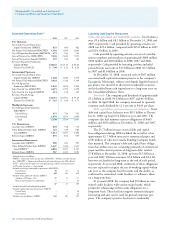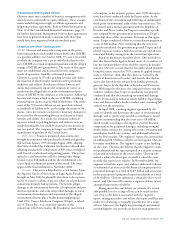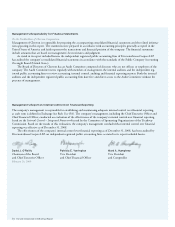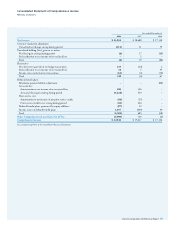Chevron 2008 Annual Report Download - page 53
Download and view the complete annual report
Please find page 53 of the 2008 Chevron annual report below. You can navigate through the pages in the report by either clicking on the pages listed below, or by using the keyword search tool below to find specific information within the annual report.Chevron Corporation 2008 Annual Report 51
and assumptions, including those deemed “critical,” and
the associated disclosures in this discussion have been dis-
cussed by management with the Audit Committee of the
Board of Directors.
The areas of accounting and the associated “critical” esti-
mates and assumptions made by the company are as follows:
Pension and Other Postretirement Benefit Plans The
determination of pension-plan obligations and expense is
based on a number of actuarial assumptions. Two critical
assumptions are the expected long-term rate of return on
plan assets and the discount rate applied to pension plan
obligations. For other postretirement benefit (OPEB) plans,
which provide for certain health care and life insurance
benefits for qualifying retired employees and which are not
funded, critical assumptions in determining OPEB obliga-
tions and expense are the discount rate and the assumed
health care cost-trend rates.
Note 22, beginning on page 82, includes information
on the funded status of the company’s pension and OPEB
plans at the end of 2008 and 2007; the components of pen-
sion and OPEB expense for the three years ending December
31, 2008; and the underlying assumptions for those periods.
Pension and OPEB expense is recorded on the Con-
solidated Statement of Income in “Operating expenses” or
“Selling, general and administrative expenses” and applies to
all business segments. The year-end 2008 and 2007 funded
status, measured as the difference between plan assets and
obligations, of each of the company’s pension and OPEB
plans is recognized on the Consolidated Balance Sheet. The
funded status of overfunded pension plans is recorded as a
long-term asset in “Deferred charges and other assets.” The
funded status of underfunded or unfunded pension and
OPEB plans is recorded in “Accrued liabilities” or “Reserves
for employee benefit plans.” Amounts yet to be recognized
as components of pension or OPEB expense are recorded in
“Accumulated other comprehensive loss.”
To estimate the long-term rate of return on pension
assets, the company uses a process that incorporates actual
historical asset-class returns and an assessment of expected
future performance and takes into consideration external
actuarial advice and asset-class factors. Asset allocations are
periodically updated using pension plan asset/liability stud-
ies, and the determination of the company’s estimates of
long-term rates of return are consistent with these studies.
The expected long-term rate of return on U.S. pension plan
assets, which account for 68 percent of the company’s pen-
sion plan assets, has remained at 7.8 percent since 2002. For
the 10 years ending December 31, 2008, actual asset returns
averaged 3.7 percent for this plan. The actual asset returns
for the 10 years ending December 31, 2007, averaged 8.7
percent. The actual return for 2008 was negative and was
associated with the broad decline in the financial markets in
the second half of the year.
The year-end market-related value of assets of the major
U.S. pension plan used in the determination of pension
expense was based on the market value in the preceding three
months, as opposed to the maximum allowable period of five
years under U.S. accounting rules. Management considers
the three-month period long enough to minimize the effects
of distortions from day-to-day market volatility and still be
contemporaneous to the end of the year. For other plans,
market value of assets as of year-end is used in calculating the
pension expense.
The discount rate assumptions used to determine U.S.
and international pension and postretirement benefit plan
obligations and expense reflect the prevailing rates available
on high-quality fixed-income debt instruments. At Decem-
ber 31, 2008, the company selected a 6.3 percent discount
rate for the major U.S. pension and postretirement plans.
This rate was selected based on a cash flow analysis that
matched estimated future benefit payments to the Citigroup
Pension Discount Yield Curve as of year-end 2008. The
discount rates at the end of 2007 and 2006 were 6.3 percent
and 5.8 percent, respectively.
An increase in the expected long-term return on plan
assets or the discount rate would reduce pension plan expense,
and vice versa. Total pension expense for 2008 was $770 mil-
lion. As an indication of the sensitivity of pension expense to
the long-term rate of return assumption, a 1 percent increase
in the expected rate of return on assets of the company’s
primary U.S. pension plan would have reduced total pen-
sion plan expense for 2008 by approximately $70 million.
A 1 percent increase in the discount rate for this same plan,
which accounted for about 61 percent of the companywide
pension obligation, would have reduced total pension plan
expense for 2008 by approximately $140 million.
An increase in the discount rate would decrease the
pension obligation, thus changing the funded status of a
plan recorded on the Consolidated Balance Sheet. The total
pension liability on the Consolidated Balance Sheet at
December 31, 2008, for underfunded plans was approxi-
mately $4.0 billion. As an indication of the sensitivity of
pension liabilities to the discount rate assumption, a 0.25 per-
cent increase in the discount rate applied to the company’s
primary U.S. pension plan would have reduced the plan obli-
gation by approximately $250 million, which would have
decreased the plan’s underfunded status from approximately
$2.0 billion to $1.8 billion. Other plans would be less under-
funded as discount rates increase. The actual rates of return
on plan assets and discount rates may vary significantly from
estimates because of unanticipated changes in the world’s
financial markets.
In 2008, the company’s pension plan contributions were
$839 million (including $577 million to the U.S. plans). In
2009, the company estimates contributions will be approxi-
mately $800 million. Actual contribution amounts are
























